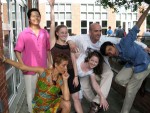Title
After five hours of traveling, we arrived at Williams College, located in the Berkshires in Williamstown, Mass. Fourth-year doctoral pianist Quentin Kim, fourth-year actor Nick Choksi, fourth-year violinist Hanah Stuart, fourth-year pianist Stephanie Chen, third-year violinist Tony Song, and I had been selected to accompany dance faculty member Stephen Pier, artistic director of Juilliard’s Mentoring program, and music faculty member Milica Paranosic, the Mentoring program’s associate director, as part of the artistic team comprising—as we would later learn—a crucial element of the Catalyst Project.
Body
Organized by the American Psychological Association, the Catalyst Project is a weeklong retreat at the end of June attended by 12 high school students who have demonstrated a strong interest in chemistry and are committed to a yearlong research project. The retreat serves as a launching point for these projects and introduces the participants to the Master-Associate-Scholar (MAS) relationship, which the A.P.A. considers essential to professional development. The aspiring chemists, known as “scholars” in the program, are divided into groups that conduct project-related research under the guidance of a master (top-ranking college professor) and two associates (graduate students). When we met the 4 masters, 8 associates, and 12 scholars attending the program, we felt like black rats in a group of white lab mice. It was difficult to imagine how we artists would be integrated, especially since the week’s schedule was already packed with MAS meetings, science lectures, question/answer sessions, and mealtime discussions. The one question on all of our minds was, “So exactly what are we doing here?”
The answer became clear when Rena Subotnik, director of the center for psychology in schools and education at the American Psychological Association, introduced us and explained another objective of the retreat: “We want the scholars to become conscious of the creative process, and it’s so much easier to see in the artistic world.” For this reason, Pier and two other artists had been invited to host master classes during the week. Pier’s class was last, but definitely not least. Barefoot in the campus’s only dance studio, the scholars seemed uneasy at first. But after an hour of choreographing and dancing a short movement phrase, the wonderfully open-minded and enthusiastic high-schoolers were all smiles.
As unforgettable as the dance choreography session was, the six of us Juilliard students were most influential when we least intended. For example, when attending lectures and presentations, we asked questions from artists’ perspectives that were challenging for the masters and scholars to answer without using chemistry terminology that we wouldn’t understand. In addition, what began one evening as Kim practicing a composition on the piano in the residence hall quickly became, at the scholars’ requests, an impromptu concert during which we all performed. Even our mealtime conversations became avenues through which the scholars gained a deeper appreciation of the role of art in society. Our presence at the Catalyst Project introduced these students to a new lifestyle and way of thinking, while also leaving them hungry for more exposure to the arts.
Scholar Frances Shi, who enters her junior year this fall, understood the importance of our contributions. “These experiences broke down the barrier [between science and art]. I realized that science is not so black and white anymore,” she said. “You can’t find some of these answers directly, which is why we need to be exposed to art … to learn to think in a different way.”
Subotnik was also aware of the benefits of surrounding the scholars with artists. “Not only is the artistic component the most memorable for the kids, it also strengthens life lessons about pursuing a career when they hear about your commitment to training and appreciate how much time it has taken to reach your skill level,” she said. “You have the pride of your profession, and that’s something they’re striving for, too.”
By the end of the week, Kim, Choksi, Stuart, Chen, Song, and I were no longer uncertain about our role in the Catalyst Project. We were taking the first steps toward promoting the fusion of art and science in the minds of young scientists so that by the time they become leaders, their newly cultivated ways of thinking will better prepare them to tackle the issues they’ll face in a field that becomes more unknown with every discovery, and more important with every breakthrough.





